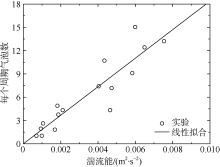| [1] |
韩磊, 袁业立, 2007. 波浪破碎卷入气泡的泡径分布理论模型[J]. 中国科学 D辑: 地球科学, 37(9): 1273-1279.
|
| [2] |
蒋昌波, 王刚, 邓斌, 等, 2015. 不同尺度水平并列气泡运动特性三维数值研究[J]. 应用基础与工程科学学报, 23(2): 233-245.
|
|
JIANG CHANGBO, WANG GANG, DENG BIN, et al, 2015. Three-dimensional numerical simulation of movement characteristic of two parallel rising bubbles with different scales[J]. Journal of Basic Science and Engineering, 23(2): 233-245 (in Chinese with English abstract).
|
| [3] |
张阿漫, 2006. 水下爆炸气泡三维动态特性研究[D]. 哈尔滨: 哈尔滨工程大学.
|
|
ZHANG AMAN, 2006. 3D dynamic behavior of underwater explosion bubble[D]. Harbin:Harbin Engineering University (in Chinese with English abstract).
|
| [4] |
张淑君, 吴锤结, 2008. 气泡之间相互作用的数值模拟[J]. 水动力学研究与进展, 23(6): 681-686.
|
|
ZHANG SHUJU, WU CHUIJIE, 2008. Numerical Simulation of the Interactions Between two three-dimensional deformable bubbles[J]. Chinese Journal of Hydrodynamics, 23(6): 681-686 (in Chinese with English abstract).
|
| [5] |
张书文, 2008. 波浪破碎气体的卷入过程及相关统计量的估计[J]. 物理学报, 57(5): 3287-3292.
|
|
ZHANG SHUWEN, 2008. Air bubble entrainment by breaking waves and estimation of the related statistical quantities[J]. Acta Physica Sinica, 57(5): 3287-3292 (in Chinese with English abstract).
|
| [6] |
BESANT W H, 1859. Hydrostatics and hydrodynamics[M]. London: Cambridge University press.
|
| [7] |
BLENKINSOPP C E, CHAPLIN J R, 2007. Void fraction measurements in breaking waves[J]. Proceedings of the Royal Society A: Mathematical, Physical and Engineering Sciences, 463(2088): 3151-3170.
|
| [8] |
BLENKINSOPP C E, CHAPLIN J R, 2010. Bubble size measurements in breaking waves using optical fiber phase detection probes[J]. IEEE Journal of Oceanic Engineering, 35(2): 388-401.
|
| [9] |
BLENKINSOPP C E, CHAPLIN J R, 2011. Void fraction measurements and scale effects in breaking waves in freshwater and seawater[J]. Coastal Engineering, 2011, 58(5): 417-428.
|
| [10] |
DEIKE L, LENAIN L, MELVILLE W K, 2017. Air entrainment by breaking waves[J]. Geophysical Research Letters, 44(8): 3779-3787.
|
| [11] |
DEIKE L, MELVILLE W K, POPINET S, 2016. Air entrainment and bubble statistics in breaking waves[J]. Journal of Fluid Mechanics, 801: 91-129.
|
| [12] |
HOQUE A, AOKI S I, 2005. Distributions of void fraction under breaking waves in the surf zone[J]. Ocean Engineering, 32(14-15): 1829-1840.
|
| [13] |
HOQUE A, 2008. Studies of water level rise by entrained air in the surf zone[J]. Experimental Thermal and Fluid Science, 32(4): 973-979.
|
| [14] |
HOQUE A, AOKI S I, 2014. Wave-energy dissipation and wave setup caused by entrained air bubbles in plunging wave breaking[J]. Journal of Waterway, Port, Coastal, and Ocean Engineering, 140(5): 172-182.
|
| [15] |
INAMURO T, OGATA T, OGINO F, 2004. Numerical simulation of bubble flows by the lattice Boltzmann method[J]. Future Generation Computer Systems, 20(6): 959-964.
|
| [16] |
JACOBSEN N G, FUHRMAN D R, FREDSØE J, 2012. A wave generation toolbox for the open-source CFD library: OpenFoam®[J]. International Journal for Numerical Methods in Fluids, 70(9): 1073-1088.
|
| [17] |
LIM H J, CHANG KUANGAN, HUANG ZHICHENG, et al, 2015. Experimental study on plunging breaking waves in deep water[J]. Journal of Geophysical Research: Oceans, 120(3): 2007-2049.
|
| [18] |
WELLER H G, 2002. Derivation modelling and solution of the conditionally averaged two-phase flow equations[R]., Technical Report No. TR/HGW/02, London: Nabla Ltd.
|
| [19] |
WILLMOTT C J, 1981. On the validation of models[J]. Physical Geography, 2(2): 184-194.
|
| [20] |
ZHANG LIXI, HAN FANGCHAO, GAO SHIYUAN, 2011. Numerical simulations and comparisons of air bubbling process through single hole[M]//JIN D, LIN S. Advances in computer science, intelligent system and environment. Berlin Heidelberg: Springer: 371-377.
|
 ), 唐瑶1, 蒋昌波1,2,3(
), 唐瑶1, 蒋昌波1,2,3( ), 王孟飞1
), 王孟飞1
 ), Yao TANG1,2,3, Changbo JIANG1,2,3(
), Yao TANG1,2,3, Changbo JIANG1,2,3( ), Mengfei WANG1
), Mengfei WANG1





















